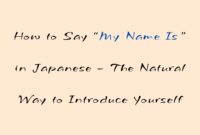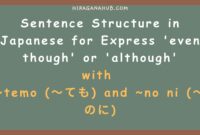Combining Adjectives with なる and する (くなる/になる、くする/にする)
In this lesson, we will learn how to combine adjectives with two important
verbs in Japanese: なる (naru) and
する (suru). This process is quite similar to the previous
lesson on turning adjectives into adverbs, with some similar conjugation
rules. Let’s start with the first one!

Combining i-Adjectives and the Verb Naru (なる)
Combining an i-adjective with なる (naru) means “to become.”
To form this combination, we change the ending い (i) into
く (ku) and add the verb なる (naru).
Example:
-
白い (shiroi) = white →
白くなる (shiroku naru) = to become white -
強い (tsuyoi) = strong →
強くなる (tsuyoku naru) = to become strong -
弱い (yowai) = weak →
弱くなる (yowaku naru) = to become weak -
長い (nagai) = long →
長くなる (nagaku naru) = to become long -
甘い (amai) = sweet →
甘くなる (amaku naru) = to become sweet
Example sentences with なる:
-
私の犬はとても強くなった
Watashi no inu wa totemo tsuyoku natta
My dog became very strong. -
秋になると、葉が赤くなる
Aki ni naru to, ha ga akaku naru
In autumn, the leaves turn red. -
夏になると、空が明るくなる
Natsu ni naru to, sora ga akaruku naru
When summer comes, the sky becomes brighter.
Polite Version of Naru (なる)
Besides the basic form なる (naru), in formal or polite
situations, we use the more polite form なります (narimasu).
The function and meaning of this form remain the same but are more appropriate
in conversations or situations requiring politeness.
Example sentences with なります (narimasu):
-
私の犬はとても強くなります
Watashi no inu wa totemo tsuyoku narimasu
My dog will become very strong. -
秋になると、葉が赤くなります
Aki ni naru to, ha ga akaku narimasu
In autumn, the leaves will turn red. -
夏になると、空が明るくなります
Natsu ni naru to, sora ga akaruku narimasu
When summer comes, the sky will become brighter.
Combining Na-Adjectives and the Verb Naru (なる)
For na-adjectives, we simply add に (ni) after the adjective
before adding なる (naru). Example:
-
綺麗 (kirei) = beautiful →
綺麗になる (kirei ni naru) = to become beautiful -
有名 (yuumei) = famous →
有名になる (yuumei ni naru) = to become famous -
元気 (genki) = healthy →
元気になる (genki ni naru) = to become healthy -
静か (shizuka) = quiet →
静かになる (shizuka ni naru) = to become quiet -
上手 (jouzu) = skillful →
上手になる (jouzu ni naru) = to become skillful
Example sentences with なる:
-
彼は毎日勉強して、日本語が上手になった
Kare wa mainichi benkyou shite, nihongo ga jouzu ni natta
He studied every day and became good at Japanese. -
ここは夏になるととても静かになる
Koko wa natsu ni naru to totemo shizuka ni naru
It becomes very quiet here when summer comes.
Combining i-Adjectives and the Verb Suru (する)
Now, let’s look at how to combine i-adjectives with
する (suru). In this case, we also change the ending
い (i) into く (ku) and add
する (suru). The meaning of this combination is “to make
something…,” or “to do something in a… manner.” Example:
-
大きい (ookii) = big →
大きくする (ookiku suru) = to make bigger -
深い (fukai) = deep →
深くする (fukaku suru) = to make deeper -
遅い (osoi) = slow →
遅くする (osoku suru) = to make slower
Example sentences with する:
-
この川をもっと深くしてください
Kono kawa o motto fukaku shite kudasai
Please make the river deeper. -
この部屋を広くしてください
Kono heya o hiraku shite kudasai
Please make this room bigger.
Combining Na-Adjectives and the Verb Suru (する)
Finally, we will look at combining na-adjectives with
する (suru). The process is the same as with
なる, except we replace なる (naru) with
する (suru). The meaning of this combination is “to make
something…” or “to turn something into…”. Example:
-
綺麗 (kirei) = beautiful →
綺麗にする (kirei ni suru) = to make beautiful -
上手 (jouzu) = skillful →
上手にする (jouzu ni suru) = to make skillful -
複雑 (fukuzatsu) = complicated →
複雑にする (fukuzatsu ni suru) = to make complicated
Example sentences with する:
-
彼女は部屋をきれいにしました
Kanojo wa heya o kirei ni shimashita
She cleaned the room. -
彼は料理を上手にしました
Kare wa ryouri o jouzu ni shimashita
He made the cooking very skillful.
Conclusion
In this lesson, we learned how to combine adjectives with
なる (naru) and する (suru) to create more
complex sentences. With this understanding, you can more easily express
changes or actions related to a certain quality in Japanese. Don’t be afraid
to keep practicing and making mistakes, as that’s how we learn. See you in the
next lesson!


